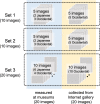Universality and superiority in preference for chromatic composition of art paintings
- PMID: 35277597
- PMCID: PMC8917196
- DOI: 10.1038/s41598-022-08365-z
Universality and superiority in preference for chromatic composition of art paintings
Abstract
Color composition in paintings is a critical factor affecting observers' aesthetic judgments. We examined observers' preferences for the color composition of Japanese and Occidental paintings when their color gamut was rotated. In the experiment, observers were asked to select their preferred image from original and three hue-rotated images in a four-alternative forced choice paradigm. Despite observers' being unfamiliar with the presented artwork, the original paintings (0 degrees) were preferred more frequently than the hue-rotated ones. Furthermore, the original paintings' superiority was observed when the images were divided into small square pieces and their positions randomized (Scrambled condition), and when the images were composed of square pieces collected from different art paintings and composed as patchwork images (Patchwork condition). Therefore, the original paintings' superiority regarding preference was quite robust, and the specific objects in the paintings associated with a particular color played only a limited role. Rather, the original paintings' general trend in color statistics influenced hue-angle preference. Art paintings likely share common statistical regulations in color distributions, which may be the basis for the universality and superiority of the preference for original paintings.
© 2022. The Author(s).
Conflict of interest statement
The authors declare no competing interests.
Figures






Similar articles
-
Regularity of colour statistics in explaining colour composition preferences in art paintings.Sci Rep. 2022 Aug 26;12(1):14585. doi: 10.1038/s41598-022-18847-9. Sci Rep. 2022. PMID: 36028748 Free PMC article.
-
An independent contribution of colour to the aesthetic preference for paintings.Vision Res. 2020 Dec;177:109-117. doi: 10.1016/j.visres.2020.08.005. Epub 2020 Oct 10. Vision Res. 2020. PMID: 33045445
-
The colors of paintings and viewers' preferences.Vision Res. 2017 Jan;130:76-84. doi: 10.1016/j.visres.2016.11.006. Epub 2016 Dec 10. Vision Res. 2017. PMID: 27913105
-
Emotion in Painting and Art Installations.Am J Psychol. 2015 Fall;128(3):305-22. doi: 10.5406/amerjpsyc.128.3.0305. Am J Psychol. 2015. PMID: 26442338 Review.
-
Statistical regularities in art: Relations with visual coding and perception.Vision Res. 2010 Jul 21;50(16):1503-9. doi: 10.1016/j.visres.2010.05.002. Epub 2010 May 16. Vision Res. 2010. PMID: 20580643 Review.
Cited by
-
Regularity of colour statistics in explaining colour composition preferences in art paintings.Sci Rep. 2022 Aug 26;12(1):14585. doi: 10.1038/s41598-022-18847-9. Sci Rep. 2022. PMID: 36028748 Free PMC article.
-
The perceived beauty of art is not strongly calibrated to the statistical regularities of real-world scenes.Sci Rep. 2024 Aug 21;14(1):19368. doi: 10.1038/s41598-024-69689-6. Sci Rep. 2024. PMID: 39169117 Free PMC article.
-
Natural color composition induces oddball P3 asymmetry associated with processing fluency.Sci Rep. 2025 Feb 10;15(1):4878. doi: 10.1038/s41598-025-88815-6. Sci Rep. 2025. PMID: 39929900 Free PMC article.
-
Efficient quantization of painting images by relevant colors.Sci Rep. 2023 Feb 21;13(1):3034. doi: 10.1038/s41598-023-29380-8. Sci Rep. 2023. PMID: 36810612 Free PMC article.
-
A novel flexible identity-net with diffusion models for painting-style generation.Sci Rep. 2025 Jul 31;15(1):27896. doi: 10.1038/s41598-025-12434-4. Sci Rep. 2025. PMID: 40744991 Free PMC article.
References
-
- Fechner GT. Uber die Frage des goldenen Schnittes [On the question of the golden section] Archiv fur die Zeichnenden Kunste. 1865;11:100–112.
-
- Ramachandran V, Hirstein W. The science of art: A neurological theory of aesthetic experience. J. Conscious. Stud. 1999;6:15–51.
-
- Silvia PJ. Emotional responses to art: From collation and arousal to cognition and emotion. Rev. Gen. Psychol. 2005;9:342–357.
-
- Cinzia DD, Vittorio G. Neuroaesthetics: A review. Curr. Opin. Neurobiol. 2009;19:682–687. - PubMed
-
- Chatterjee A. Neuroaesthetics: A coming of age story. J. Cogn. Neurosci. 2010;23:53–62. - PubMed
Grants and funding
LinkOut - more resources
Full Text Sources

